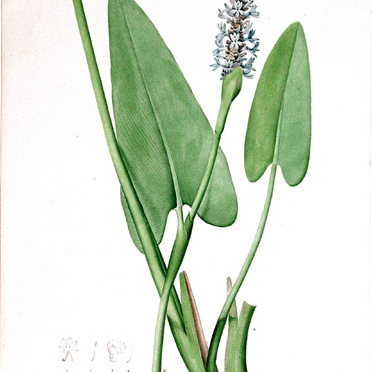Herbs, annual or perennial, rooted in mud. Vegetative stems submersed and growing to surface, or rhizomatous. Flowering stems submersed and growing to surface, or emersed and slightly constricted just below first node. Sessile leaves forming basal rosette, blade thin. Petiolate leaves floating or emersed; blade cordate to reniform, apex obtuse to acuminate. Inflorescences spicate, commonly 50 or more-flowered, elongating over many days; spathes folded, apex acute to acuminate; peduncle glandular-pubescent or pilose. Flowers open 1 day only; perianth mauve, blue, or white, funnelform, limb lobes oblong to oblanceolate, glandular-pubescent or pilose, apex obtuse to acuminate; stamens 6, distal 3 shorter than proximal 3; filaments purple, glandular-pubescent; anthers yellow, ovoid to oblong; ovary 3-locular, only 1 developing to maturity; ovule 1; style 1 or more. Fruits utriculate, ovoid, with spinulose, dentate or smooth longitudinal ridges. Seed 1, ovoid, smooth.
Fls trimorphically heterostylic; perianth blue to white, funnelform with bilabiate limb, the 3 lower lobes nearly or quite distinct, the 3 upper united about half their length, the middle upper lobe broader than the lateral and marked with yellow; stamens 6, inserted on the perianth-tube, the 3 opposite the lower lip exsert, those opposite the upper lip included and sometimes reduced or sterile; ovary 3-locular, one locule with a single pendulous ovule, the other 2 smaller and empty; nectaries septal; fr achene-like, enclosed within the accrescent perianth-tube, and beaked with the persistent style-base; marsh or aquatic herbs, often colonial, with broad or narrow lvs; infl a contracted spike-like panicle, the long stalk arising from the rhizome and bearing one lf with an expanded blade and above it a bladeless sheath. 3, New World.
Plants attached, ±glabrous. Rhizome bearing clustered stems and basal leaves. Flowering stems erect. Cauline leaf lamina ±erect. Inflorescence a spike-like panicle; peduncle not deflexed after anthesis. Flowers tristylous or (not in Australia) homostylous. Perianth zygomorphic, 2-lipped, revolute above after anthesis; lobes unequal, partly connate into a tube. Filaments free, half longer than others; anthers ±equal, dorsifixed and versatile, opening by longitudinal slits. Ovary unilocular. Fruit a 1-seeded nutlet, enclosed by hardened base of perianth. Seed (not seen in Australian collections) obloid or reniform.
Perennial marsh or aquatic herbs. Leaves petioled, erect, blade narrow or broad. Inflorescence short or long-spicate, pedunculate, with basal spathe. Spadix and outer perianth more or less hairy, often glandular. Perianth bilabiate, lower 3 segments free, upper 3 adnate for their basal half, middle lobe expanded and with yellow spot. Stamens 6, unequal, posterior 3 included in the throat, fila-ments adnate toward their base. Ovary with 1 fertile cell containing a single anatropous ovule; style elongate, slender. Fruit achenoid, with persistent style and perianth parts and several protruding or ridge-like crests.

